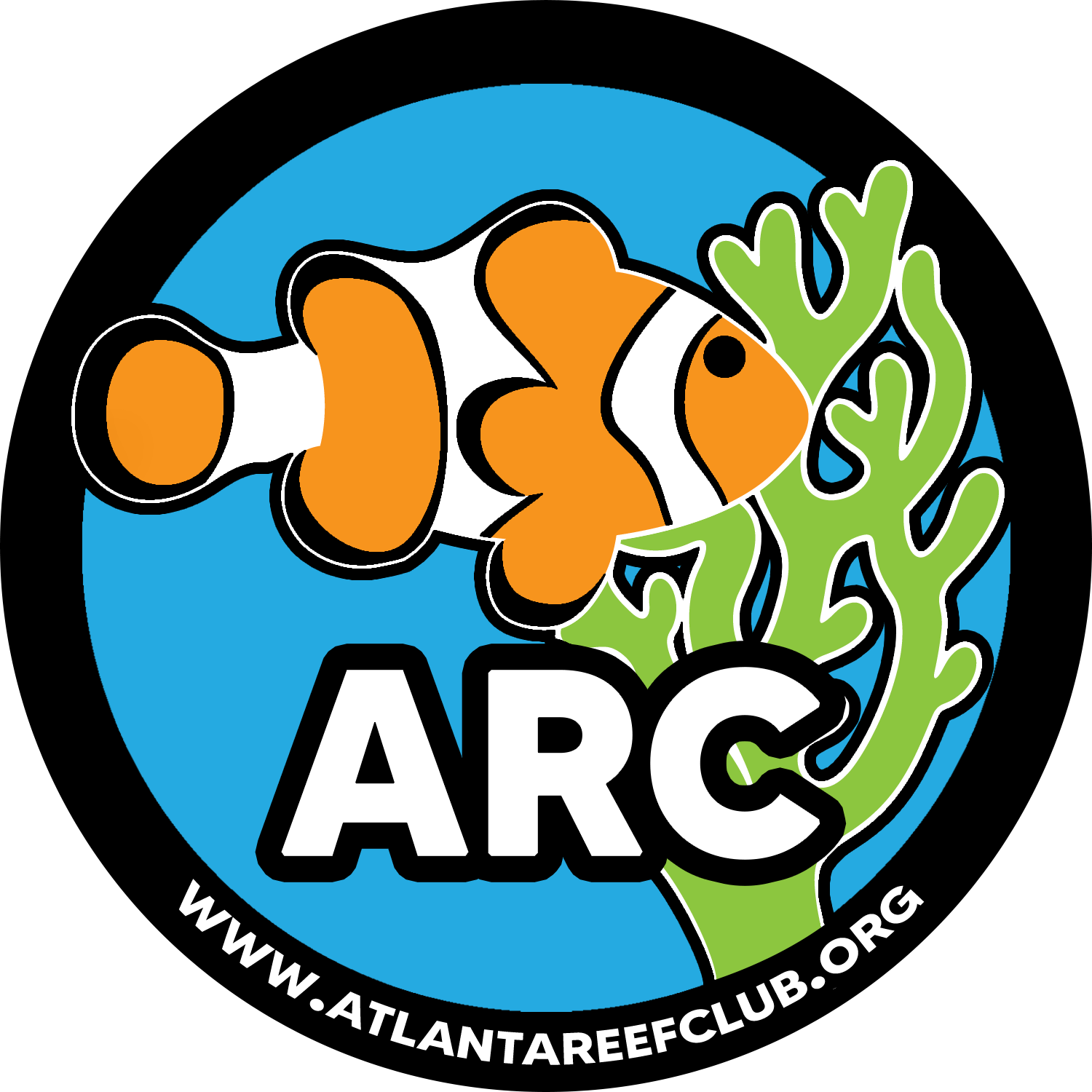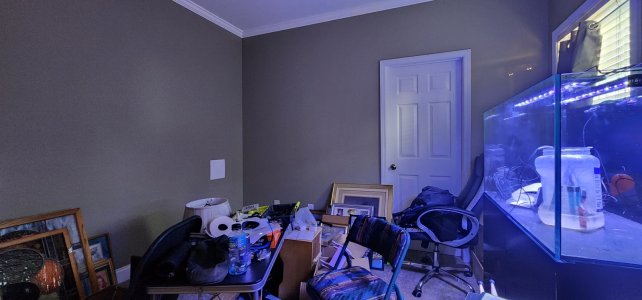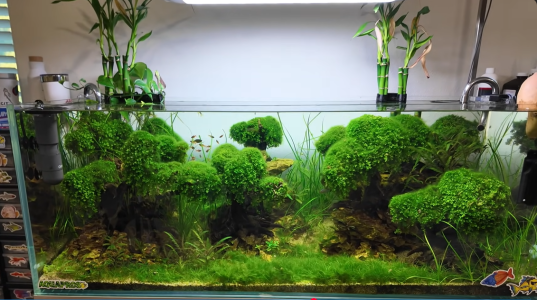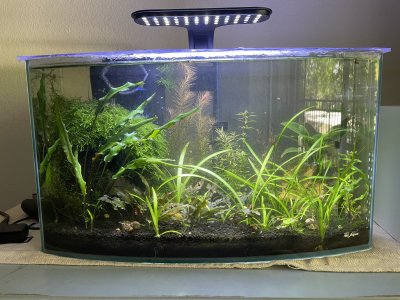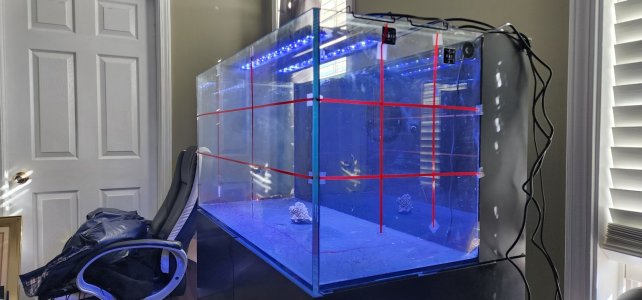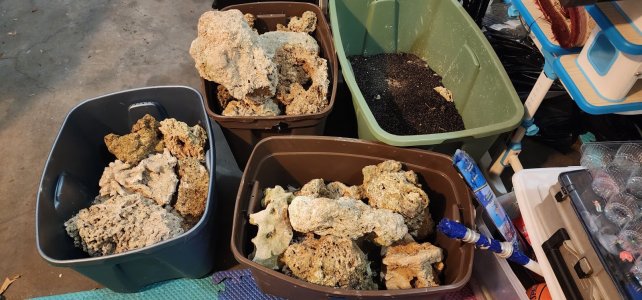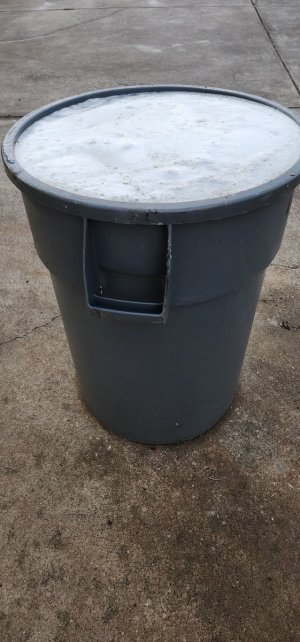This is my office where I work 35 - 70 hours a week (not to mention the time I spend in here to hide because my children are being too noisy). It's almost as if the Waterbox 50.3 AIO was designed to fit in this space... or the space was designed for the tank, take your pick:
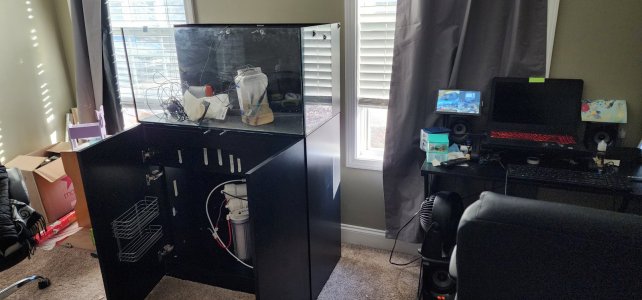
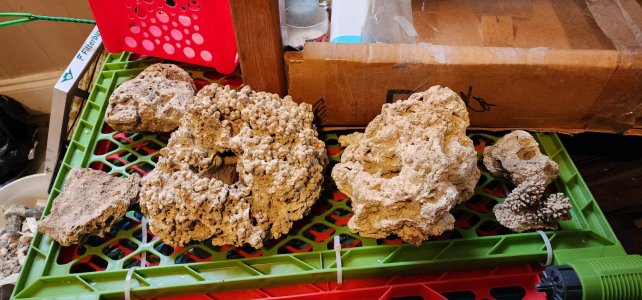
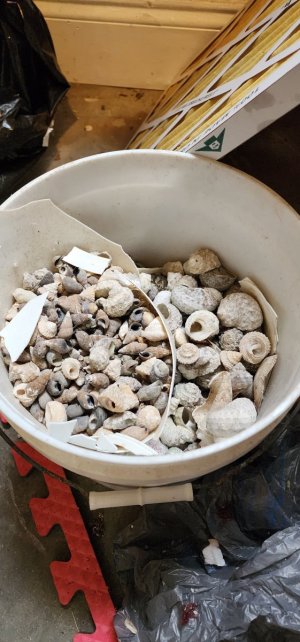
Also, my bit 'o rock and bucket of shells - it looks like I might have a line on more live rock than I can use, if I want to drive clear across town to get it, that is. If you've got spare dry rock you're looking to get rid of for free or cheap and are nearby, please send a DM, I'm definitely interested.
I was originally planning on expanding my desk into that space where the tank is sitting. Either the tank or the added desk space could go to my right (and a bit behind, from the perspective of the camera - it's a corner desk, there's more stuff there). I'm torn, though - I'm left-eye dominant, and so tend to favor working that direction, even though I'm right handed. I love the idea of the tank being just there (though I hope the noise won't get to me - I'm on the autism spectrum, and sensitive to such things), BUT, also... it's not visible on my camera when I'm on calls and I kind of want to be able to show off
and I kind of want to be able to show off  Still, I think I want to see it more than I want others to, especially since I can't have my drums in my office any more like I did at my last place - maybe I can at least get cognitive breaks looking at fish.
Still, I think I want to see it more than I want others to, especially since I can't have my drums in my office any more like I did at my last place - maybe I can at least get cognitive breaks looking at fish.
Frankly, the biggest problem with it being right there (aside from pump/skimmer noise) that I can see is that I am also light sensitive, particularly on migraine days... which unfortunately happens about weekly, and I tend to keep it fairly dim in my office regardless. So I'm running tests with the lights on (though the tank is empty) to see how well I cope in the meantime, and I guess if it winds up staying there, my migraine days are going to wind up being rainy/cloudy days for the corals. Maybe I can put a curtain on it
Thankfully, the washer/dryer room is immediately behind my office (behind left, from camera). I went ahead and punched a hole in the wall and covered with a removable panel so that I can access the cold water line for my RO/DI and the drain for water changes, which will go a LONG way towards minimizing hassle and making sure I actually do maintenance. That also happens to be the same wall that would be visible behind me on camera though then I'd have to turn around to see the tank. That would, however, also put it right next to the access panel for the water and drain.
though then I'd have to turn around to see the tank. That would, however, also put it right next to the access panel for the water and drain.
To the left of the left-most window, I'm punching a hole in the exterior wall to run some cabling for exterior cameras and WiFi antennae, and while I'm at it I'm going to run an air-line to connect to my skimmer - there are 4 adults, 2 children and 5 cats between the 3 levels of our home (we'll be adding a German Shepherd soon, too), and I tend to keep my office door closed during the day. As a result, I want to try to reduce pH drops from atmospheric CO2, which I already struggle with in my freshwater tank where I'm adding 1/8 to 1/4 tbsp of soda ash a week to that 29g bow, irrespective of water changes, just to maintain a pH of 7.0.
Aquascaping is going to be a bit of a challenge, because I have to consider both the angled perspective from which I will usually view the tank from my desk, as well as from the front-on. I think I have my head wrapped around it, but I need more rock than I have before I can get started. I'm still considering if I want to try to plan for an eel pot, which I do kinda think I want.
Looks like I'll be picking up salt soon now that the group buy is ready. I think I need new media for the RO/DI. Also picking up a Power Bar 8 (not one of the fancy ones) shortly as well. I'm planning on a ~3" bed of black sand. I need wave pumps, a python, and other misc stuff. A QT tank, I guess (anyone got a spare 20 long for sale?) I haven't figured out what I want to use to mix up salt in, but I don't think doing it 5 gallons at a time is a sustainable plan, and need a large container and I guess a pump for it. Need to settle on a skimmer and pick which heaters I want to go with. A light and pump for the fuge, and a step bit to drill it with. ATO kit for said ATO. And finally, I need misc. chemicals/additives and test kits, and then I think I'll be ready to start filling as soon as I finish 'scaping.
One thing at a time, holidays were awful expensive this year: here's to hoping my taxes aren't.



Also, my bit 'o rock and bucket of shells - it looks like I might have a line on more live rock than I can use, if I want to drive clear across town to get it, that is. If you've got spare dry rock you're looking to get rid of for free or cheap and are nearby, please send a DM, I'm definitely interested.
I was originally planning on expanding my desk into that space where the tank is sitting. Either the tank or the added desk space could go to my right (and a bit behind, from the perspective of the camera - it's a corner desk, there's more stuff there). I'm torn, though - I'm left-eye dominant, and so tend to favor working that direction, even though I'm right handed. I love the idea of the tank being just there (though I hope the noise won't get to me - I'm on the autism spectrum, and sensitive to such things), BUT, also... it's not visible on my camera when I'm on calls
Frankly, the biggest problem with it being right there (aside from pump/skimmer noise) that I can see is that I am also light sensitive, particularly on migraine days... which unfortunately happens about weekly, and I tend to keep it fairly dim in my office regardless. So I'm running tests with the lights on (though the tank is empty) to see how well I cope in the meantime, and I guess if it winds up staying there, my migraine days are going to wind up being rainy/cloudy days for the corals. Maybe I can put a curtain on it
Thankfully, the washer/dryer room is immediately behind my office (behind left, from camera). I went ahead and punched a hole in the wall and covered with a removable panel so that I can access the cold water line for my RO/DI and the drain for water changes, which will go a LONG way towards minimizing hassle and making sure I actually do maintenance. That also happens to be the same wall that would be visible behind me on camera
To the left of the left-most window, I'm punching a hole in the exterior wall to run some cabling for exterior cameras and WiFi antennae, and while I'm at it I'm going to run an air-line to connect to my skimmer - there are 4 adults, 2 children and 5 cats between the 3 levels of our home (we'll be adding a German Shepherd soon, too), and I tend to keep my office door closed during the day. As a result, I want to try to reduce pH drops from atmospheric CO2, which I already struggle with in my freshwater tank where I'm adding 1/8 to 1/4 tbsp of soda ash a week to that 29g bow, irrespective of water changes, just to maintain a pH of 7.0.
Aquascaping is going to be a bit of a challenge, because I have to consider both the angled perspective from which I will usually view the tank from my desk, as well as from the front-on. I think I have my head wrapped around it, but I need more rock than I have before I can get started. I'm still considering if I want to try to plan for an eel pot, which I do kinda think I want.
Looks like I'll be picking up salt soon now that the group buy is ready. I think I need new media for the RO/DI. Also picking up a Power Bar 8 (not one of the fancy ones) shortly as well. I'm planning on a ~3" bed of black sand. I need wave pumps, a python, and other misc stuff. A QT tank, I guess (anyone got a spare 20 long for sale?) I haven't figured out what I want to use to mix up salt in, but I don't think doing it 5 gallons at a time is a sustainable plan, and need a large container and I guess a pump for it. Need to settle on a skimmer and pick which heaters I want to go with. A light and pump for the fuge, and a step bit to drill it with. ATO kit for said ATO. And finally, I need misc. chemicals/additives and test kits, and then I think I'll be ready to start filling as soon as I finish 'scaping.
One thing at a time, holidays were awful expensive this year: here's to hoping my taxes aren't.
Last edited:
